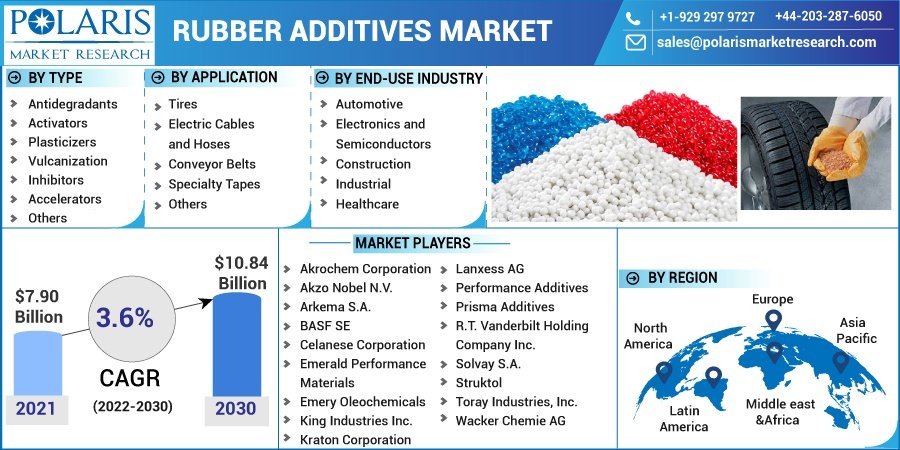The global rubber additives market is poised for significant growth, projected to expand from USD 7.90 billion in 2021 to USD 10.84 billion by 2030, reflecting a compound annual growth rate (CAGR) of 3.6% over the forecast period. This surge is driven by escalating demand in the automotive sector, advancements in manufacturing technologies, and a global shift towards sustainable materials.
Market Overview
Rubber additives are essential compounds incorporated into rubber to enhance its properties during processing and end-use applications. These additives improve rubber’s performance by increasing its strength, elasticity, durability, and resistance to heat, oxidation, and other environmental factors. Key types of rubber additives include antidegradants, accelerators, plasticizers, and curing agents, which are vital in producing high-quality rubber products for various industries, including automotive, construction, and manufacturing.
Key Market Growth Drivers
- Automotive Industry Expansion: The burgeoning automotive industry, particularly in emerging economies, is a primary driver of the rubber additives market. The increasing production of vehicles necessitates high-performance tires and components, thereby boosting the demand for rubber additives.
- Technological Advancements: Innovations in rubber processing technologies have led to the development of advanced additives that enhance the performance characteristics of rubber, such as improved heat resistance and longevity, catering to the evolving needs of end-use industries.
- Sustainability and Environmental Regulations: Stringent environmental regulations and a growing emphasis on sustainability are prompting manufacturers to adopt eco-friendly rubber additives. The development of bio-based additives and recyclable materials aligns with global efforts to reduce environmental impact.
- Infrastructure Development: Rapid urbanization and infrastructure development, especially in Asia-Pacific, are increasing the demand for rubber products in construction applications, thereby driving the rubber additives market.
Key Companies
- Akrochem Corporation
- Akzo Nobel N.V
- Arkema S.A.
- BASF SE
- Celanese Corporation
- Emerald Performance Materials
- Emery Oleochemicals
- King Industries Inc.
- Kraton Corporation
- Lanxess AG
- Performance Additives
- Prisma Additives
- T. Vanderbilt Holding Company Inc.
- Solvay S.A.
𝐄𝐱𝐩𝐥𝐨𝐫𝐞 𝐓𝐡𝐞 𝐂𝐨𝐦𝐩𝐥𝐞𝐭𝐞 𝐂𝐨𝐦𝐩𝐫𝐞𝐡𝐞𝐧𝐬𝐢𝐯𝐞 𝐑𝐞𝐩𝐨𝐫𝐭 𝐇𝐞𝐫𝐞: https://www.polarismarketresearch.com/industry-analysis/rubber-additives-market
Polaris Market Research has segmented the rubber additives market report based on type, application, end-use industry:
Rubber Additives, Type Outlook (Revenue – USD Billion, 2018 – 2030)
- Antidegradants
- Activators
- Plasticizers
- Vulcanization Inhibitors
- Accelerators
- Others
Rubber Additives, Application Outlook (Revenue – USD Billion, 2018 – 2030)
- Tires
- Electric Cables and Hoses
- Conveyor Belts
- Specialty Tapes
- Others
Rubber Additives, End-Use Industry Outlook (Revenue – USD Billion, 2018 – 2030)
- Automotive
- Electronics and Semiconductors
- Construction
- Industrial
- Healthcare
- Others
Market Challenges
- Raw Material Price Volatility: Fluctuations in the prices of raw materials, such as rubber chemicals and accelerators, can significantly impact production costs and profit margins for manufacturers.
- Regulatory Compliance: Manufacturers face challenges in adhering to stringent environmental and safety regulations, which may limit the use of certain additives and necessitate investment in research and development for compliant alternatives.
- Supply Chain Disruptions: Adverse weather conditions and geopolitical factors can disrupt the supply chain of natural rubber, affecting the availability and pricing of rubber additives.
Regional Analysis
- Asia-Pacific: Dominating the global market, Asia-Pacific accounted for a significant share in 2023, driven by robust automotive and industrial sectors in countries like China, India, and Japan. The region’s rapid industrialization and urbanization continue to fuel demand for rubber additives.
- Europe: Europe holds a substantial market share, with countries like Germany and France leading in the adoption of eco-friendly and sustainable rubber additives, influenced by stringent environmental regulations.
- North America: The North American market is characterized by advanced manufacturing technologies and a strong focus on innovation, contributing to steady growth in the rubber additives sector.
- Latin America and Middle East & Africa: These regions are witnessing gradual growth, supported by increasing industrial activities and infrastructure development, which are creating new opportunities for rubber additives manufacturers.
Conclusion
The global rubber additives market is on a growth trajectory, propelled by the expanding automotive industry, technological advancements, and a global shift towards sustainable materials. While challenges such as raw material price volatility and regulatory compliance persist, the market presents significant opportunities for innovation and expansion. Key players are investing in research and development to introduce eco-friendly and high-performance additives, ensuring the rubber additives market remains dynamic and responsive to evolving industry needs.
More Trending Latest Reports By Polaris Market Research:
Industrial Refrigeration Systems Market
Europe Transcritical CO2 Market
Hexafluoroacetone Derivatives Market
Specialty Medical Chairs Market
Pre-Engineered Building Market

